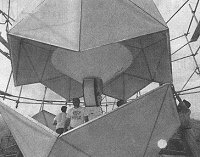
Next Generation Internet is Developing Quickly
See also: Original Japanese Article
Source: Yomiuri Shimbun, November 19, 1997
By: Toru Nishijima
NGI will open for commercial use in the U.S. in 3 years; limits on the use of new technology exist in Japan
 Photo taken by Naoko Yamagishi |
| Cellular phone networks have become widely popular. The Iridium communications satellite network enables the use of cellular phones from anywhere in the world. The antenna was placed this fall in MiMa Village in Nagano, Japan. To protect from heavy snowfall, there is a protective cover over the antenna, which is over 20 meters tall. |
NGI will become one hundred to one thousand times faster than the Internet now available. Quality security will be much improved. It will be popularized after five or ten years. Ken Kennedy, of Rice University, says that he is the authority in this field. He is Co-Chair of the advisory board appointed by President Bill Clinton to develop NGI. President Clinton has promised that the government will pay 100 million dollars per year for the NGI.
The Internet is like a pipe; if the pipe is bigger, it can send much more information. But Professor Kennedy emphasizes that the purpose of the government is not to make high speed Internet commercially available. The important thing is to provide technology which can only be used through high speed Internet. The government should push private companies to offer such service to the public.
The Internet has become very popular because of the function of the World Wide Web (WWW). Through the WWW, much information can be displayed on web pages. Currently information is still in words and images, but in the NGI, moving pictures and three-dimensional pictures will become popular. The National Science Foundation (NSF) and MCI made a big network, vBNS, for reserchers. It will probably be available for commercial use in three years. Last February, 34 universities in the United States were involved in the Internet 2 project using vBNS. Now more than 110 universities are doing research on the project. Many researchers exchange data about the atmosphere and earthquakes or the operating of an electron microscope from long distances.
These techniques will become quite common. The techniques of creating web pages were devised by an elementary particle research center. A browser to view web pages was made by a national computer research center. We cannot predict which research will develop more convenient functions and software.
Even in Japan, a lot of research on the NGI is still being done. Last month, NTT, Sony, and Keio University developed a fundamental technique for the Next Generation Internet called AMInet. If one needs to send a large amount of data, such as moving pictures, through the present Internet, the flow of the picture is sometimes delayed. AMInet was developed to prioritize the data in such a way that the moving picture will not have these pauses.
But currently there are no networks in Japan that can test this technique. Fumio Taraoka, of Sony Computer Science Laboratory, is one of the developers of AMInet; he complains, "If we had vBNS, we could refine this technique."
The Internet was developed and refined in the United States, and spread all around the world. The U.S. has started to develop the NGI, while Japan has not; Japan failed to catch on to the trend at the time, and so is much further behind than the U.S. in development of the Internet for more advanced uses in the future.
Sites & Affiliations | Leadership | Research & Applications | Major Accomplishments | FAQ | Search | Knowledge & Technology Transfer | Calendar of Events | Education & Outreach | Media Resources | Technical Reports & Publications | Parallel Computing Research Quarterly Newsletter | News Archives | Contact Information
| Hipersoft | CRPC |
© 2003 Rice University
|